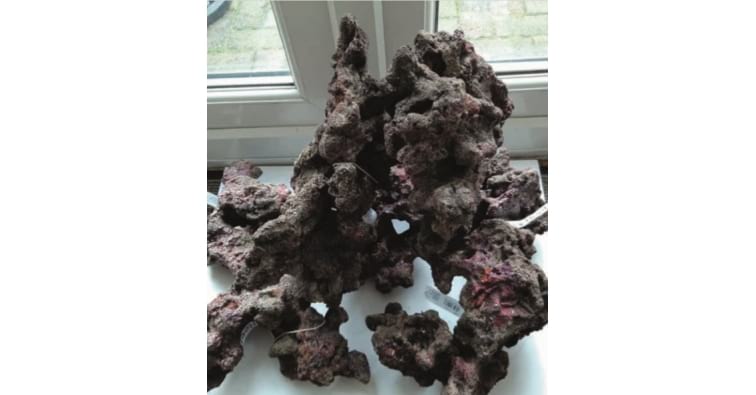



Close Look: TMC Eco Rock - Artificial Reef Rock
Choosing the right rock is one of the first and most critical choices when planning a new reef system. It not only needs to look good; it should also provide a stable physical and biological foundation over the long term.
The good news is that with a number of manufacturers now offering realistic and effective artificial reef rock, the days of being limited to unrealistic white ocean rock, dirty dead reef rock or potentially pestladen true oceanic live rock now seem a distant memory. The bad news is that there are more products than ever to choose from, each with different strengths and weaknesses, and this choice can be somewhat overwhelming at times. In this review, we examine and set-up a test system with Eco Rock the latest offering from TMC. Perhaps the first attribute one will consider when selecting rock is appearance, and out of the current crop of rock options, we personally think Eco Rock is the most realistic when compared to good quality true ocean rock. It isn’t overly gaudy and looks just as good (if not better) wet, as it does dry. What makes this product even more attractive is the variety of interesting forms that are available with arching, branching, plate-like and convoluted boulder pieces all of which offer advanced aquascaping possibilites and provide a range of microhabitats for diverse fish and invertebrate species. It is even possible to buy the product in boxes of single or mixed shapes, or even individually, giving almost unlimited combinations so no two reefs will look the same. Boxes specifically show exactly which pieces are included to help you get the look you are planning.
Out of the box (and individual bubble wrapping for each piece), the product feels quite light compared to other artificial rock products in terms of weight/density which bodes well for internal porosity and matches TMCs claim that this product is around 2.5 times lighter at the same volume than competitor products. Our shipment had survived 99% intact with just one piece of branching rock having suffered a small breakage. Rather fortuitously, this did allow us to get a look at the interior of the rock without cracking any further pieces and our initial thoughts about porosity were confirmed. We discussed this aspect of the product in detail back at Aqua2019 where TMC spokesperson James Hayes explained “EcoReef is hand made by reef communities from naturally occurring land materials, aquarium safe aggregates and is highly porous for superior bacterial loading. The rock is pH neutral, making it perfect for marine and reef aquariums and will not leach nitrates and phosphates”. Aquascaping really is exceptionally easy with this rock with the pieces locking together readily to form a stable platform, even without adhesive.
The rock is durable in this process with even the inevitable tumbles and scrapes resulting in minimal chipping or loss of finish. Of course with rock of this kind, aquascaping can be done dry and (having had several reef aquaria over the years) we find this hugely preferable to struggling with rock once it is in the aquarium… a process which inevitably leads to significant amounts of detritus, potential scratches to the tank walls and more often than not, a structure that is prone to instability. Aquascaping dry not only allows you to really take your time to perfect the structure but also then allows you to adhere the structure to provide long term stability and continuity for your reef. In short, you won’t have to worry about the whole thing collapsing and stressing (or directly damaging) your livestock every time you accidentally knock something with an algae magnet or tongs. On this subject, we used cable ties to secure our structure. Having completed our aquascaping, we carefully monitored water parameters over a several week period not only to assess the denitrification abilities of the rock, but also to check if anything was leaching from it. Without going into excessive detail, we found nothing of concern.
The rock seemed to quickly colonise with both aerobic and anaerobic bacteria leading to a small spike in Nitrate before a tail off to trace levels. Having said this, note that our bioload on the test system was extremely light and slowly added due to factors beyond our control. An ICP test after 6 weeks showed no abnormally elevated levels across the whole spread of elements. PO4 remained below 0.03. No chemical filtration was being used during this period and no water changes were performed. In summary, Eco Rock not only looks great, it also ticks all the boxes with no obvious drawbacks other than the absence of interesting and often beneficial macrofauna that real rock brings. On this subject though it is entirely possible to ask a friendly hobbyist for some beneficial ‘micro beasts’ (bristleworms, mini brittlestars, copepods/ amphipods, mysids, small molluscs etc) to seed the tank in a controlled manner. In this way you can exclude the nuisance organisms such as flatworms, valonia, asterina starfish etc but having said that, in our experience, even with systems built with artificial rock, all but the most strictly quarantined systems will eventually see pest organisms introduced. Typically, they are much slower to become a problem in such a system though, and more easily manageable.
Launched earlier in 2019, Eco Rock is already in high demand. For further information click here
Credits: Ultramarine magazine
